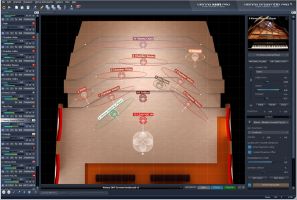Vienna Symphonic
Library (VSL) Vienna MIR

Vienna
MIR (Multi Impulse Response) is a software solution
incorporating a complete reverberation and mixing stage.
Vienna's software
developers are taking the concept of convolution reverberation
to the extreme. The application of up to 256 multi-channel
room impulses results in an enormous number of calculations
that need many innovations and ingenious programming to allow
for flawless execution on a single 64-bit computer.
But, why all the
effort? Imagine the sound of a Bösendorfer Imperial Grand. Do
you think it would be sufficient to record a single Middle C
to make for a convincing virtual instrument? Of course not.
You have to go for individual samples from as many keys as
possible, sampled in as many velocities as the human ear is
able to distinguish. The same is true for sampling a room.
What the industry has had up to now are single samples from an
acoustic entity much larger than even the biggest instruments.
There's no way you can "play" a room like that. But this is
what great rooms are all about – they want to be played by
musicians, conductors, arrangers, just like any other
instrument.
This is the
reason the Vienna Symphonic Library started to record
multi-samples from great musical venues. In fact, Vienna MIR
is more than just "a multi-sample" and this is where it far
surpasses any other convolution reverb product. Vienna MIR is
multi-source, multi-directional, multi-positional, and
multi-format. Because every room has its own voice, with its
own characteristics, its imperfections – its "magic".
Let's look at
what happens when you place a Vienna Instrument, e.g., the
solo horn, on Vienna MIR's virtual stage of a given concert
hall. First of all, the position on stage triggers the
selection of one or more sets of 8 impulses (6 for horizontal
directions, 2 for upward and downward directions). Equally
important, the directivity characteristics of each instrument
are applied before the convolution of impulses, making the
result dependent on the frequency distribution and the volume
an instrument is emitting in various directions. A horn,
directed to the rear, obviously has a different spatial
frequency profile than the frontally blaring trumpet, for
example. The MIR engine calculates all of this in real-time,
and what you get is what you hear – a solo horn that sounds
exactly as if it were playing on that very spot on stage.
Of course, you
are not limited to those spots that were used for impulse
recording in the first place. The Ambisonics format for the
impulse responses allows for seamless interpolation of each
and every point within the available areas of the room ("Hot
Spots").
The MIR
Control Icon
These new approaches to virtual orchestral music require novel
ways of handling them. Creating music is not about tweaking
thousands of parameters individually – it's about intuitive
interaction with your instrument, or with the players you've
written music for.
Vienna MIR
provides you with a well-designed control icon that gives you
an at-a-glance overview while allowing you to control almost
any sonic aspect of a given instrument with ease.
This innovative
graphical representation of an instrument and its player
allows you to shape your music from the conductor's
point-of-view. Simply ask musicians to change their position,
their orientation, their volume, without ever leaving the
whole ensemble out-of-sight. Get instant information on their
loudness, their interaction with the room and their
corresponding sonic and spatial profiles. Forget about mixing
consoles with knobs and dials, but rest assured that all of
the necessary parameters are available whenever you feel the
need to use them.
Technology:
-
Highly
specialized impulses of line arrays in 60° steps in six
horizontal directions as well as upwards and downwards.
-
Up to 40
sectors per stage for instrument placement, with
interpolation between sectors for seamless transitions.
-
Up to 5,000
individually recorded impulse responses for each room,
depending on the size of the stage and the number of
microphone positions.
-
Instrument-specific algorithms according to individual
directional frequency profiles.
-
Four-channel
Ambisonics recordings for output in various stereo and
surround formats (up to 8 output channels).
-
Recorded from
up to four carefully selected positions – from the
conductor's rostrum as well as from the audience
perspective.
Ease-of-Use:
-
Intuitive
graphic user interface with innovative multi-parameter
control icon.
-
Real-time
playing mode (low latency for arranging) and mixing mode
(higher latency due to larger buffer size for calculating up
to 20,000 convolutions during mix-down).
-
VST/AU inserts
for each instrument channel as well as the master channel.
-
Character
Presets for quick timbral changes, available for most Vienna
Instruments.
-
Advanced GUI
features such as Instrument Grouping, Hide Icon, Scroll
Zooming, etc.
Vienna
MIR Download Edition
-
Stand-alone
application for Windows XP/Vista 64 systems.
-
Runs
exclusively with Vienna Instruments.
-
Includes five
halls of the Vienna Konzerthaus.
Vienna
MIR Premium Edition
-
Boxed product,
multiple DVD-ROMs.
-
Stand-alone
application and VST/AU plug-in for OS X 10.6 (Snow Leopard)
and Windows XP/Vista 64 systems.
-
Open for Vienna
Instruments as well as any third party VSTi or other
external audio signals.
-
Additional
acoustic spaces.

